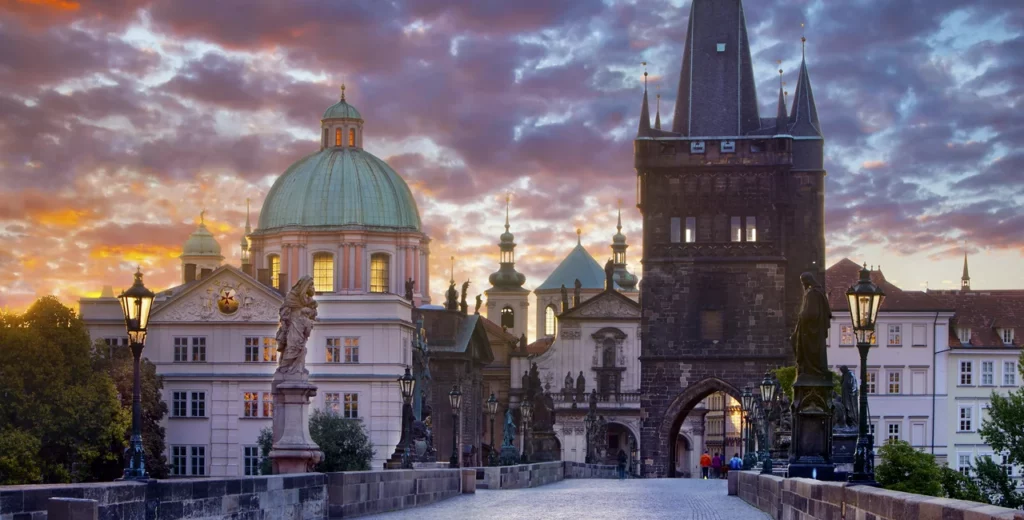
After Prague in 2 days and Prague in 3 days, here’s Prague in 4 days! Prague is an inexhaustible city, but on the strength of my long experience as an expatriate in Prague, I’ve put together a fun little program that I hope you’ll enjoy!
In this article, find out how to make the most of Prague in 4 days! Must-see sights, practical advice and good addresses for restaurants and stores from a local. Follow my lead!
Why visit Prague?
Nicknamed «the city of a hundred spires», «the golden city» or «the mother of cities», Prague is a fabulous destination! The Czech capital admirably combines history, culture and architecture. It’s a veritable open-air museum in the heart of Europe (the Czech Republic is in Central Europe – don’t say Eastern Europe, you’ll offend the locals!). At every turn, Prague will surprise and dazzle you.
An incredible wealth of architecture
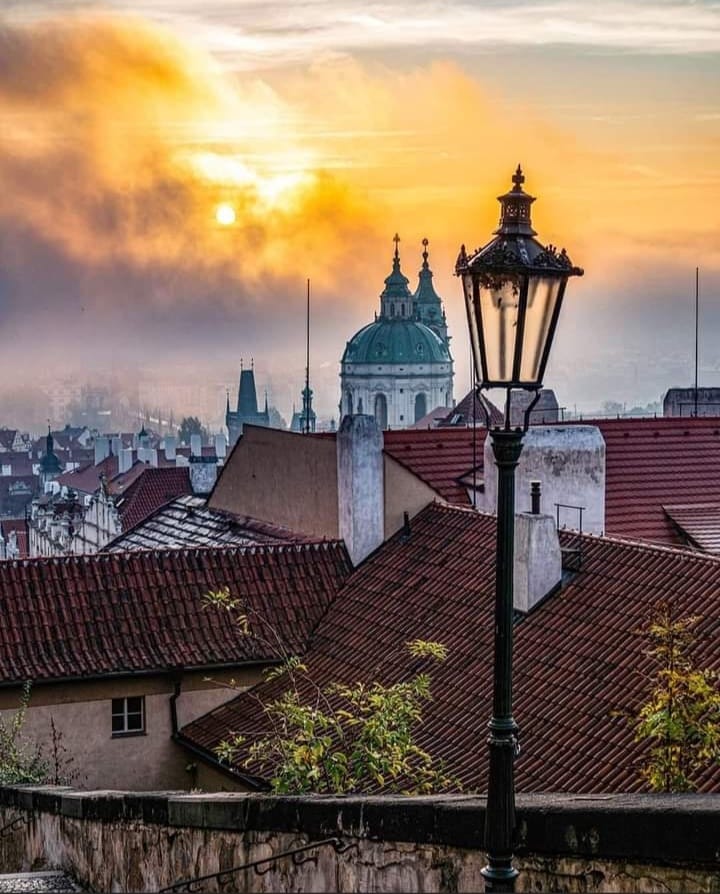
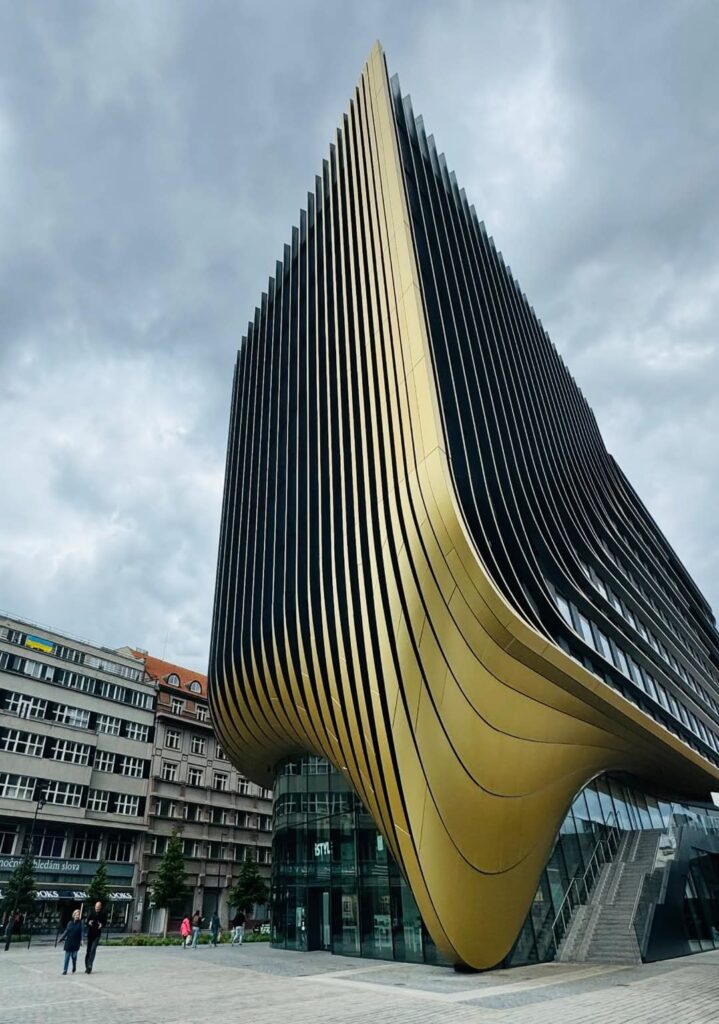
Prague is a true architectural gem, and for many visitors, the beauty of the city lies in the sometimes striking contrast between the very different architectural styles that bear witness to the city’s rich and complex past. But whether it’s Gothic, Baroque, Renaissance, Art Nouveau, Cubism, Functionalism or Brutalism, it’s all lived together harmoniously for centuries, and Prague is one of the world’s most beautiful cities!


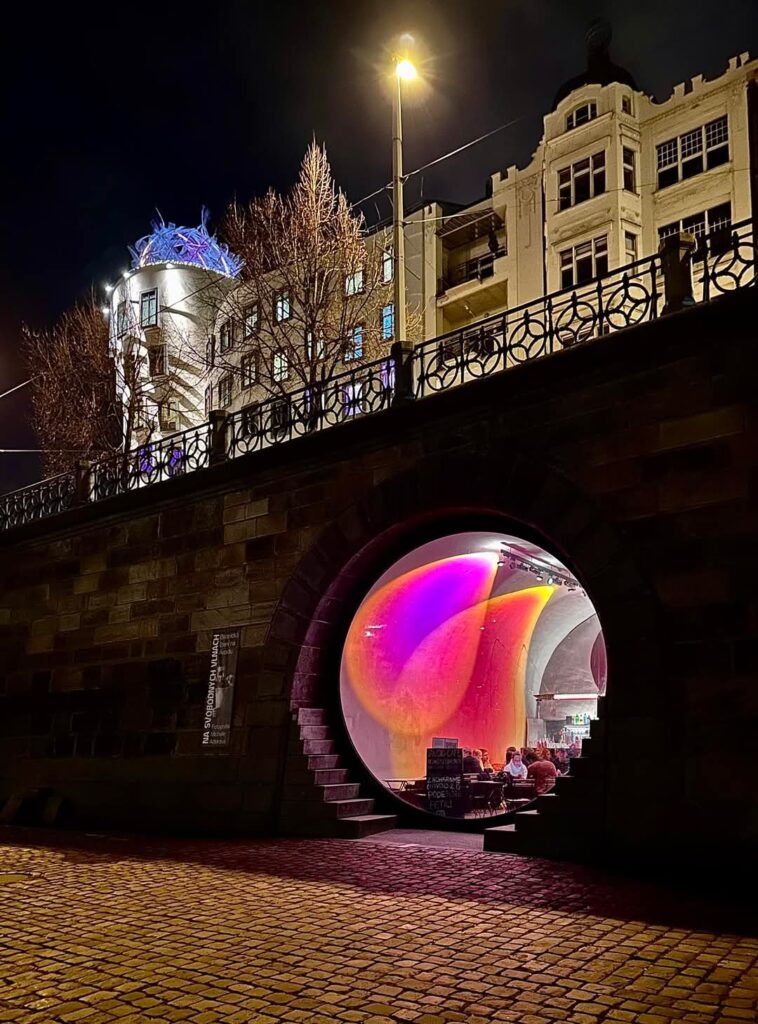
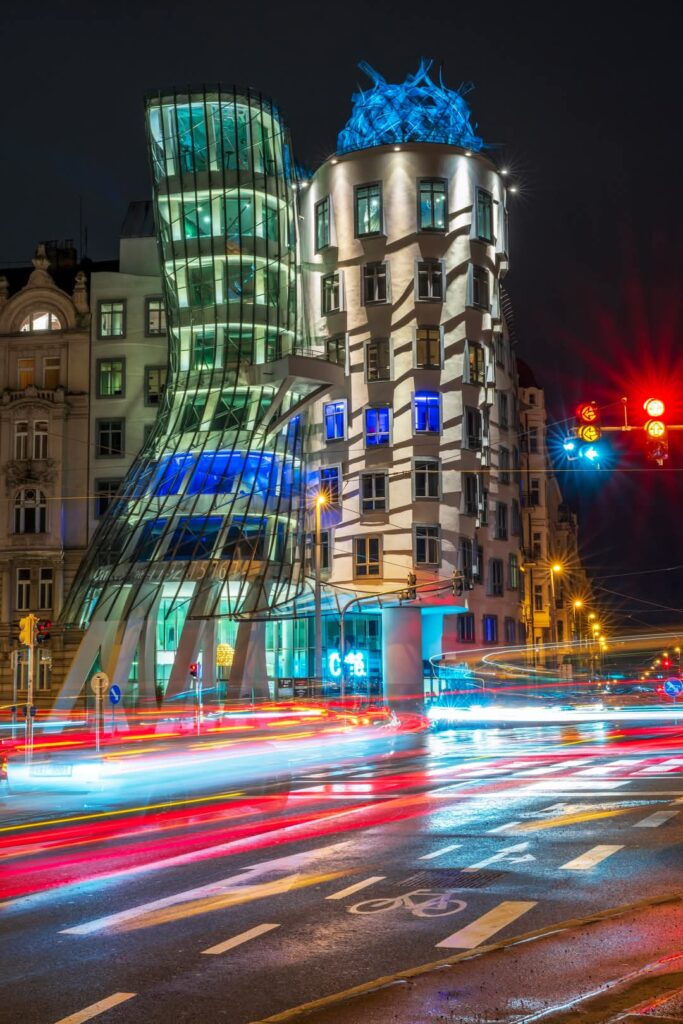
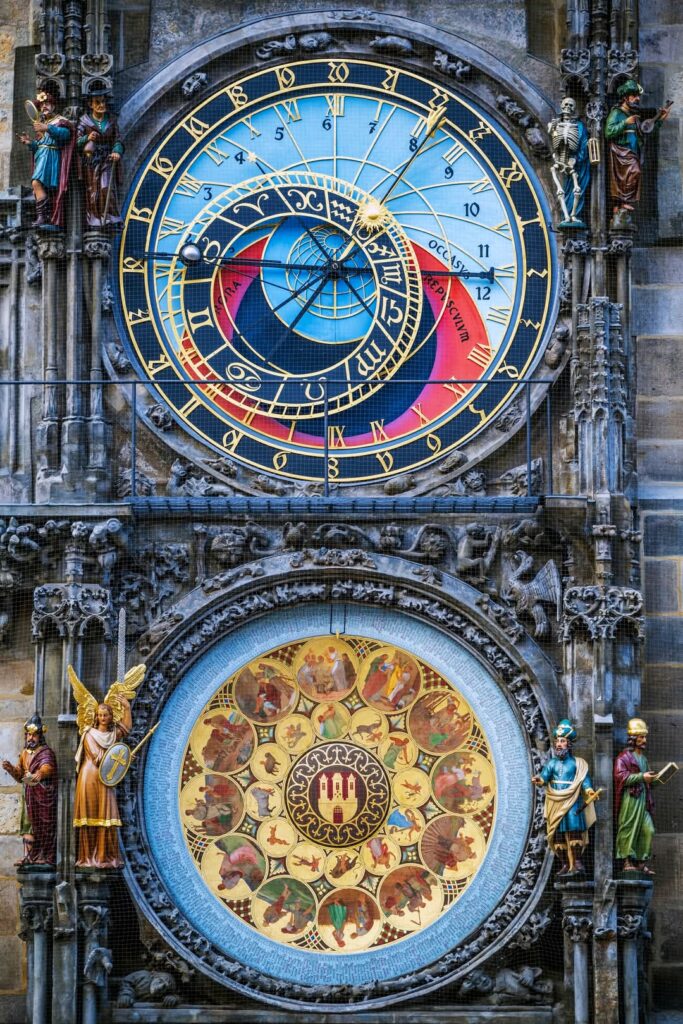
A romantic destination
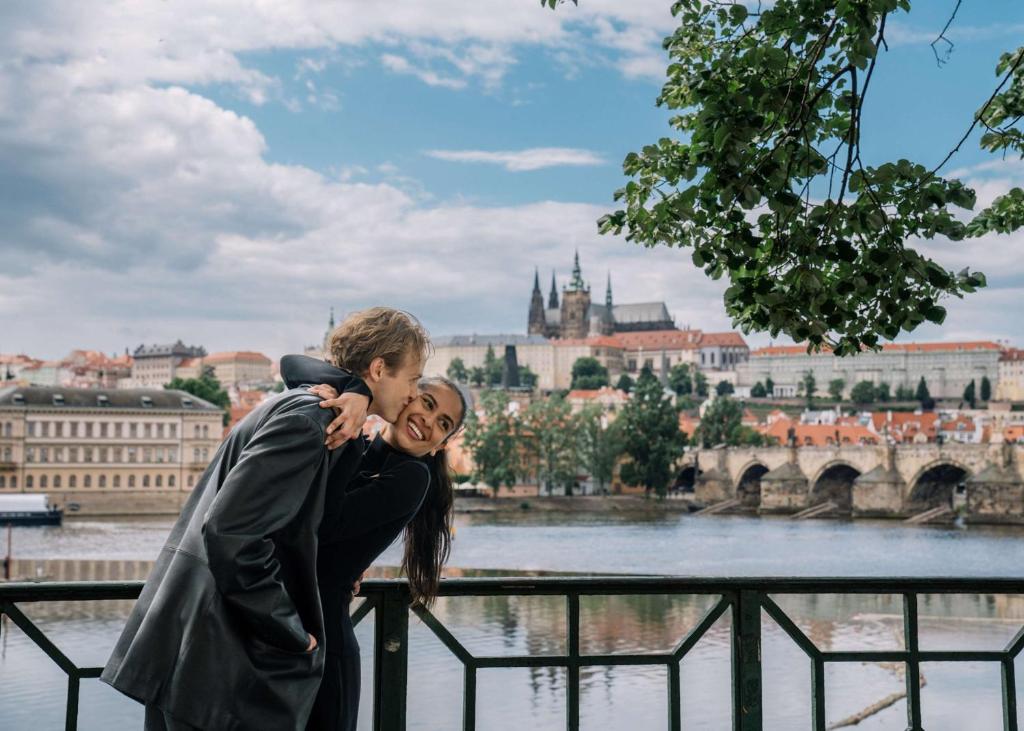
Many agree on Prague’s unique romantic atmosphere. Between the medieval charm of the Old Town and the more modern character of the New Town and its passageways, the city lends itself to strolls and strolls with its nose in the air. It’s also one of the greenest cities in the world in terms of hectares of greenery per inhabitant!

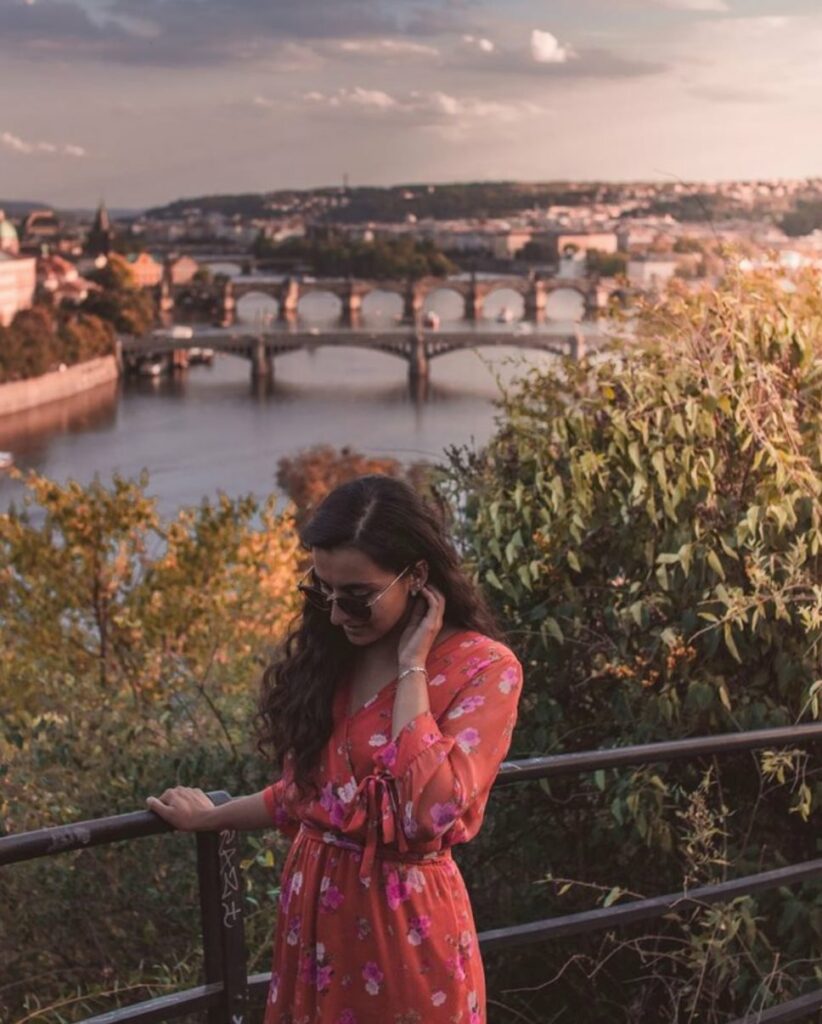
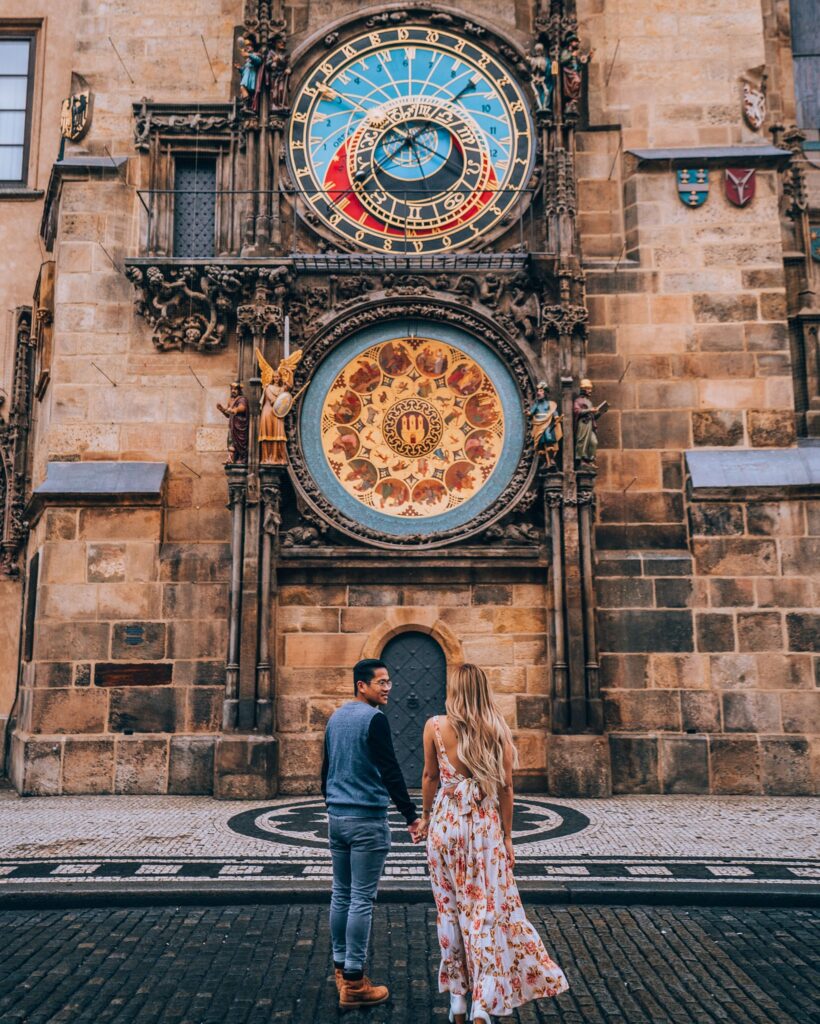
A hectic daily life

Prague isn’t just for history buffs, it’s also a lively, friendly city. It’s a very young city, with an average age of 44. Historic cafés or more secret cafés, wine bars, typical restaurants with affordable local cuisine, lively nightlife… You’ll never be bored! Czechs don’t entertain much, and almost all social life takes place outside the home (beer – of which the Czechs are by far the world’s biggest consumers – can be found where it is, i.e. on draught in a drinking establishment). The Czech Republic is a country where you can’t die of hunger or thirst!
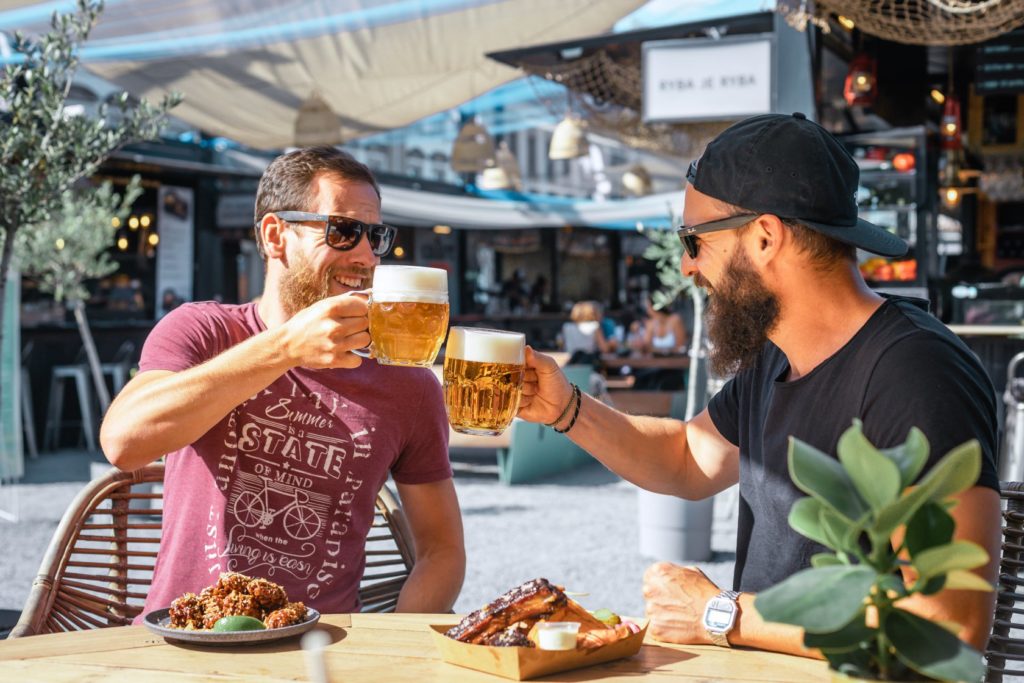
How do I get to Prague?
Getting to Prague is simple. Here are the two most common options:
- By plane
Prague’s Václav Havel airport is 30 minutes from the city center. To get to the heart of Prague, you can use public transport or take a cab. Transfers are very easy.
- By car
Where to stay in Prague?
The Czech capital offers a wide range of accommodation options to suit your budget, from youth hostels to luxury accommodation.
If you’re looking for a less touristy area to get a better idea of how Prague people live, I highly recommend the Vinohrady and Žižkov districts, which offer a much more authentic atmosphere.
Don’t hesitate to ask me if you have any questions about the hotel you’ve found!
Day 1: Arrival at the hotel and first walks
First of all, if I had to recommend a hotel, I’d definitely recommend the Mosaic House Design Hotel! I was lucky enough to test it out and all the visitors I accompany on the little guided tours I organize regularly are absolutely delighted. Location, setting and décor, comfort, cleanliness, friendly staff, breakfast… Everything is perfect!

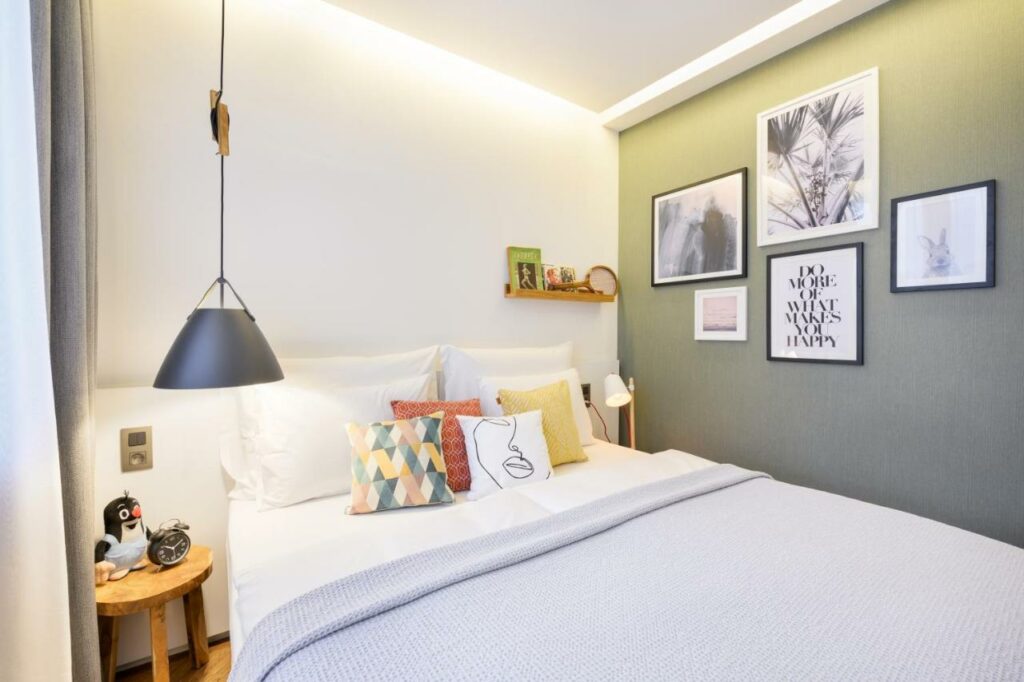
- 11 a.m. Discover Prague’s Old Town
- 1:30 p.m. Lunch break in a traditional Old Town restaurant
- 3 p.m. Panoramic view from Letná Hill
- 5 p.m. Beer bath
- 7:30 p.m. Cruise on the Vltava River
- 9 p.m. Dinner in the city
11 a.m. Discover Prague’s Old Town

A short stroll to feel the pulse of the historic heart of the «Golden City». We’re already amazed! Pastel facades, alternating patterns on the cobblestone sidewalks, the majesty of the famous Old Town Square or the adjacent «Little Square» (Malé náměstí)… Prague is a great place to stroll, and you’ll feel like you’re out of time with all these architectural styles harmoniously coexisting. Always with your nose in the air! I love the Art Nouveau facades of Valentinská, Široká or Pařížská (the famous «Rue de Paris», one of the most expensive streets in the world), in the superb Jewish Quarter!
13:30 p.m. Lunch break in a traditional Old Town restaurant


Do as the locals do and opt for the small menu of the day posted at noon on weekdays on the front door of the small brasseries and typical restaurants of the Old Town. This inexpensive little menu (soup and main course for around 10 EUR on average) is also often written (not always in English…) on loose sheets laid out on the tables. Popular addresses: U Parlamentu, Krčma or U Pivrnce. A little more expensive, but better too, Mincovna!
3 p.m. Panoramic view from Letná Hill
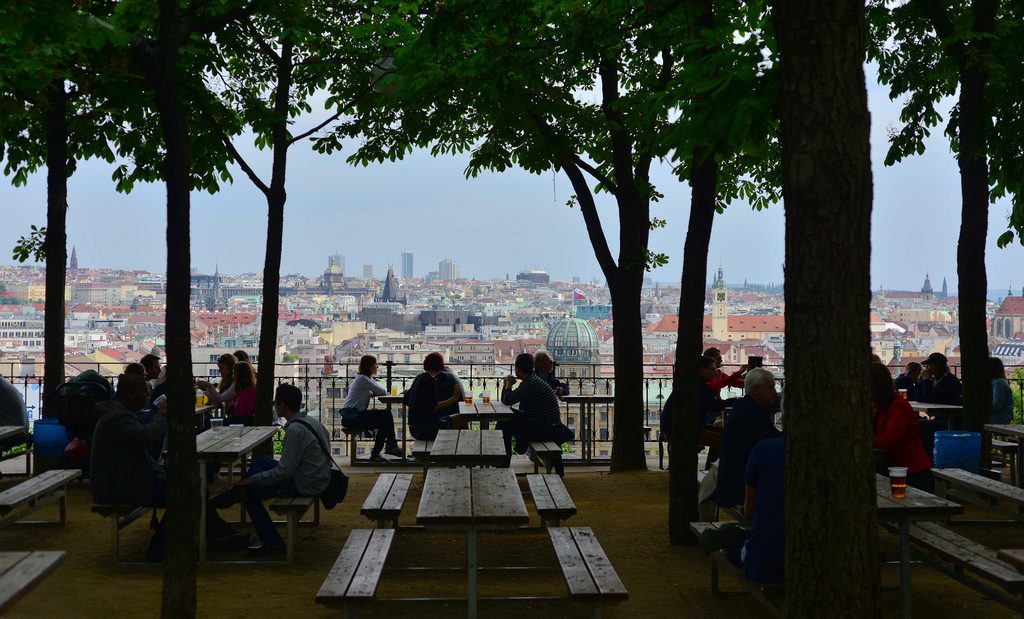
Prague is a city of hills! Only the riverbed is flat and, in my opinion, you can’t get a good feel for the city and its topography without climbing at least 3 hills (my personal favorites among the most accessible: Letná, Vítkov, Vyšehrad or Riegrovy sady…) Getting to Letná Hill from the Old Town couldn’t be easier! Simply take the aforementioned Pařížská Street, cross the Vltava River via the Art Nouveau-style Čech Bridge and climb the hill via one of the small side paths. The one to the right of the stairs (it’s less tiring and more charming to take a little path) will lead you to a beer garden and large wooden tables where locals and expats alike sit down in fine weather over a good beer (of which the Czechs are world champions in consumption, much of the national pride resting on the famous pils). The view from Letná hill is breathtaking. Probably the city’s finest panorama. You can return down the hill via the stairs this time. Today, they are dominated by a huge red metronome installed after the Velvet Revolution of 1989. Until the early 60s, a gigantic granite statue of Stalin stood here. Many Praguers regret this statue. Not for the ideology it represented, of course, but for its monumental appearance.
5 p.m. Beer bath
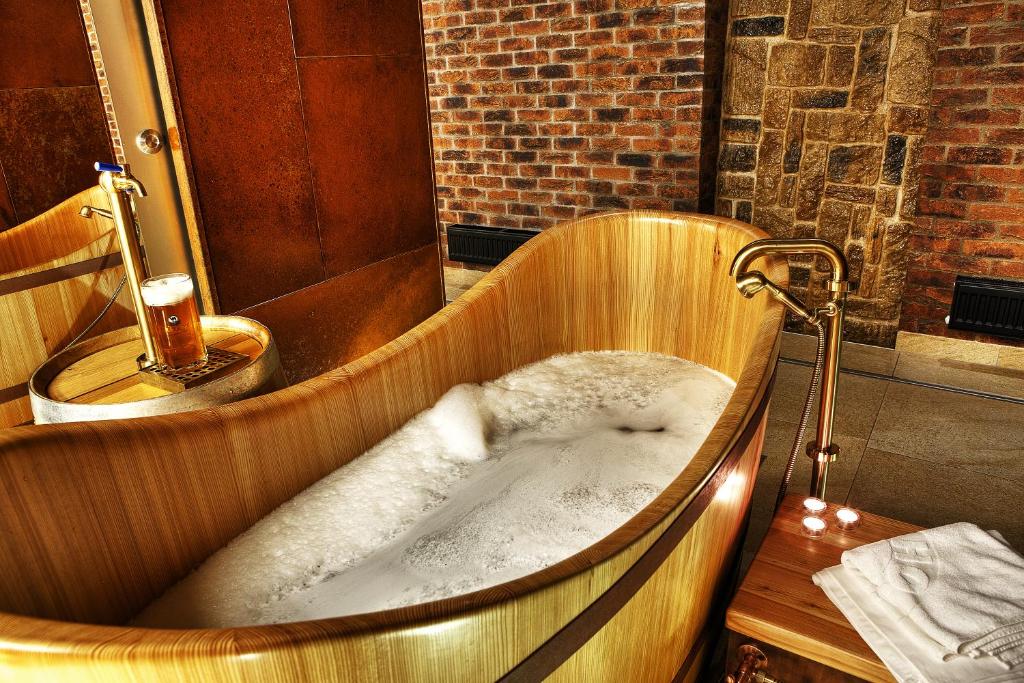
If you haven’t decided to extend your Letná beer garden experience (in fine weather, it’s very tempting to linger there, you’ll see!), why not immerse yourself in a warm beer bath? It’s just as relaxing as the previous experience, but even more surprising. All Czech popular culture revolves around beer (as a souvenir, you can even bring back one of Prague’s classic souvenirs, beer shampoo…), so why not try one of Prague’s most unusual activities? Many hotels offer beer baths, and the concept can also be found in the Old Town. The brewer Bernard’s beer bath is surely the most popular! With unlimited beer consumption thanks to a fountain… Hops and yeast are said to have many benefits for skin, hair and nails.
To book a beer bath in Prague, click here.
Good to know! The beer bath or spa is thought to have originated in Bohemia in the Middle Ages. In monasteries, beer was used for curative purposes. Today, it’s mainly used for its moisturizing, antioxidant and relaxing properties. A real anti-stress activity!
7:30 p.m. Cruise on the Vltava River
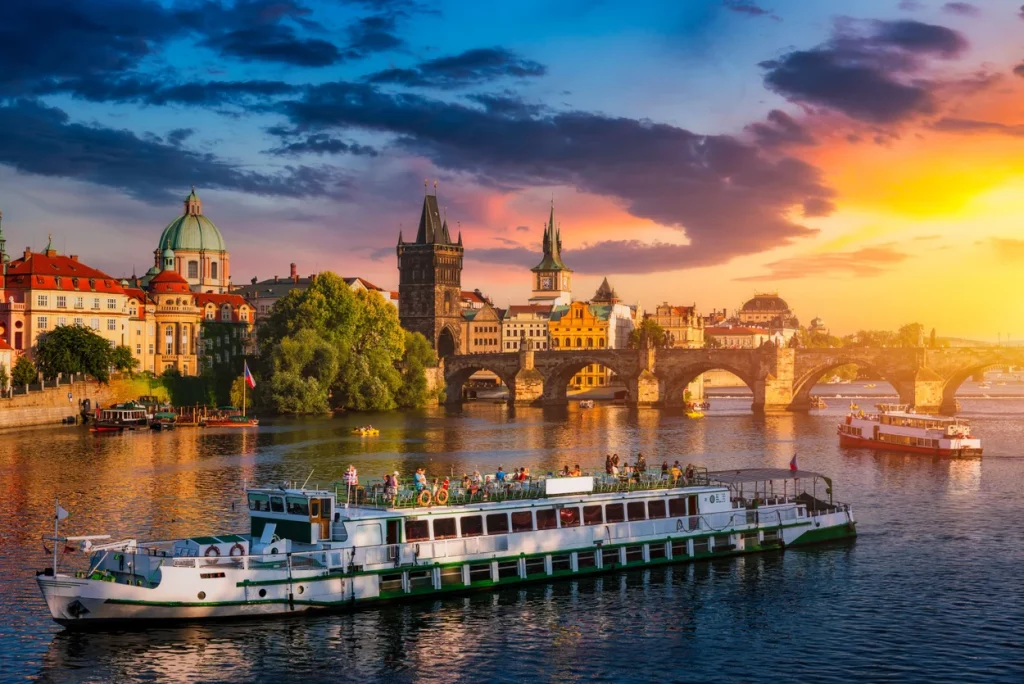
Taking a cruise on the Vltava River is not an absolute must (just as you don’t have to get on a bateau-mouche to discover Paris). But from experience, I can tell you that you’ll have a great time! So if you’ve come to Prague to relax, a cruise is a great way to discover the city and its emblematic Vltava River. Called Moldau in German, the Vltava is considered a symbol of the Czech Republic. It inspired the Moldau or Vltava movement in the symphonic poem Má Vlast by Bedřich Smetana, one of the greatest Czech composers.
To book a cruise in Prague, click here.
9 p.m. Dinner in town
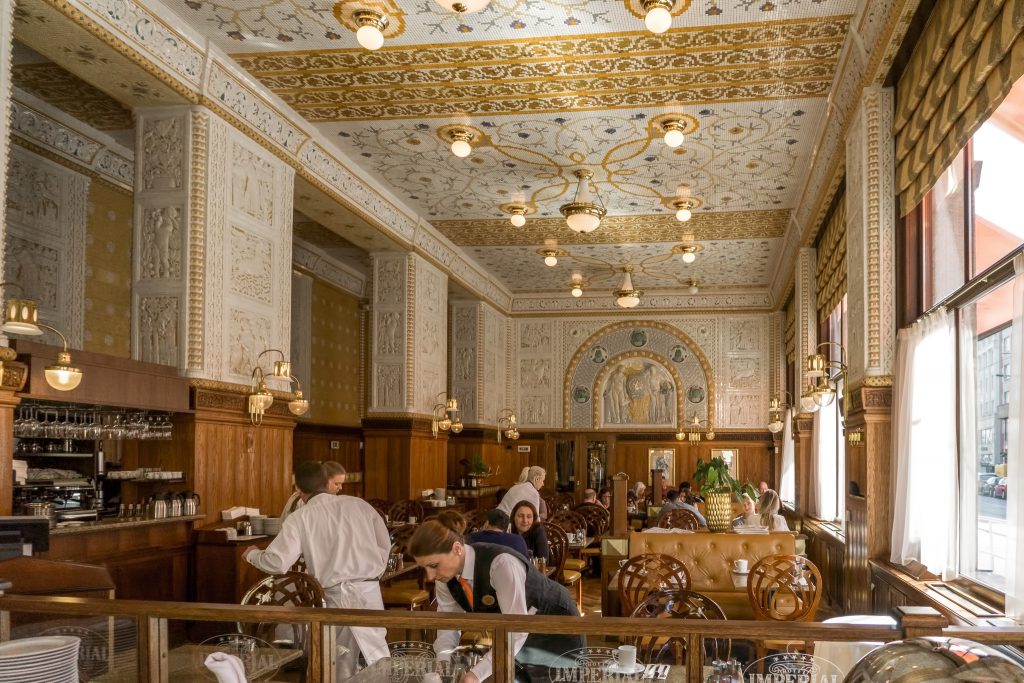
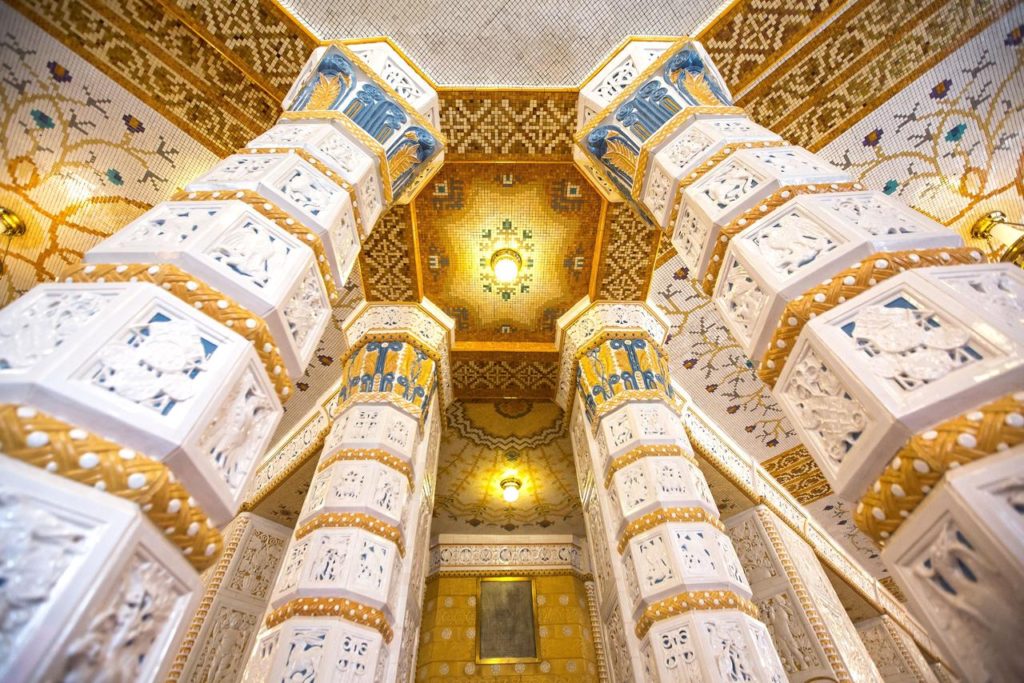
To round off this wonderful day, sit down to dinner in a good restaurant. If you want to continue your discovery of Czech cuisine with an international twist, I recommend Červený Jelen. A very Prague-style restaurant, just like the very nice Asian restaurant Sia right next door (Asian cuisine is very famous in Prague!) Finally, I’d also recommend the famous Café Imperial (remember to book for lunch or dinner, but non-stop service) where some lucky people will have booked a room in this establishment with its superb Art Deco hall that doubles as a hotel.
Day 2: In-depth discovery of the city
- 9 a.m. Breakfast
- 10 a.m. Visit to Prague Castle and Lobkowicz Palace
- 1 p.m. Lunch break
- 2 p.m. Malá Strana district, John Lennon Wall, Kampa Island and the famous Charles Bridge
- 5 p.m. Prague Astronomical Clock
- 6:30 p.m. The Dancing House
- 8 p.m. Mozart or medieval dinner
9 a.m. Breakfast
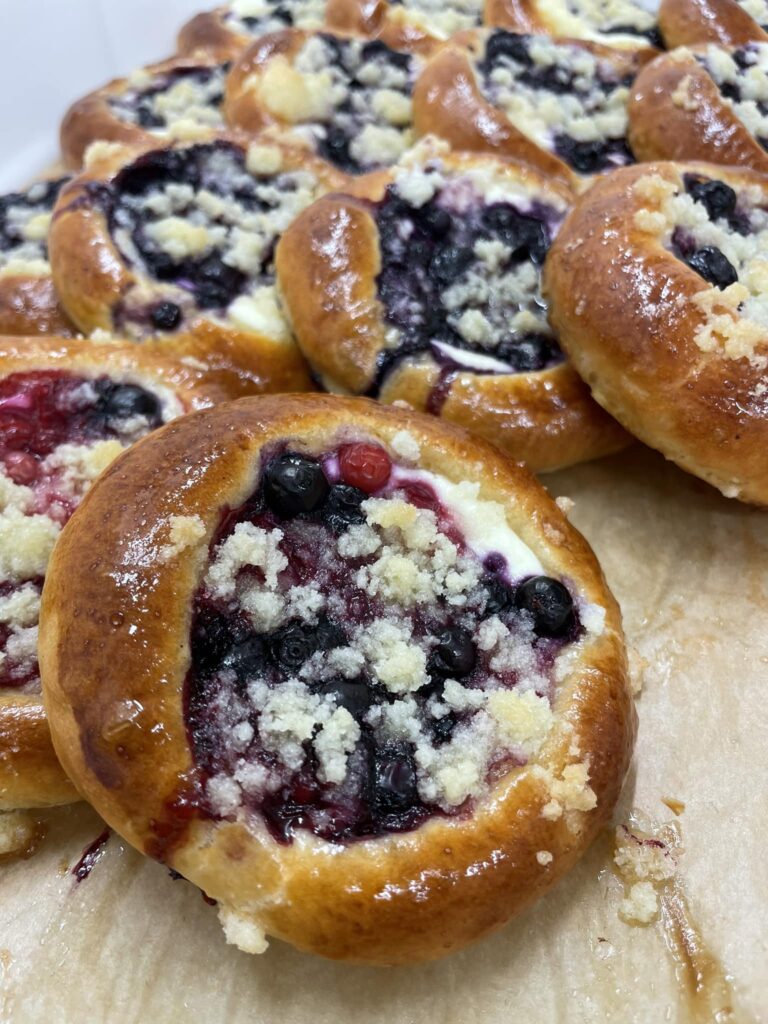
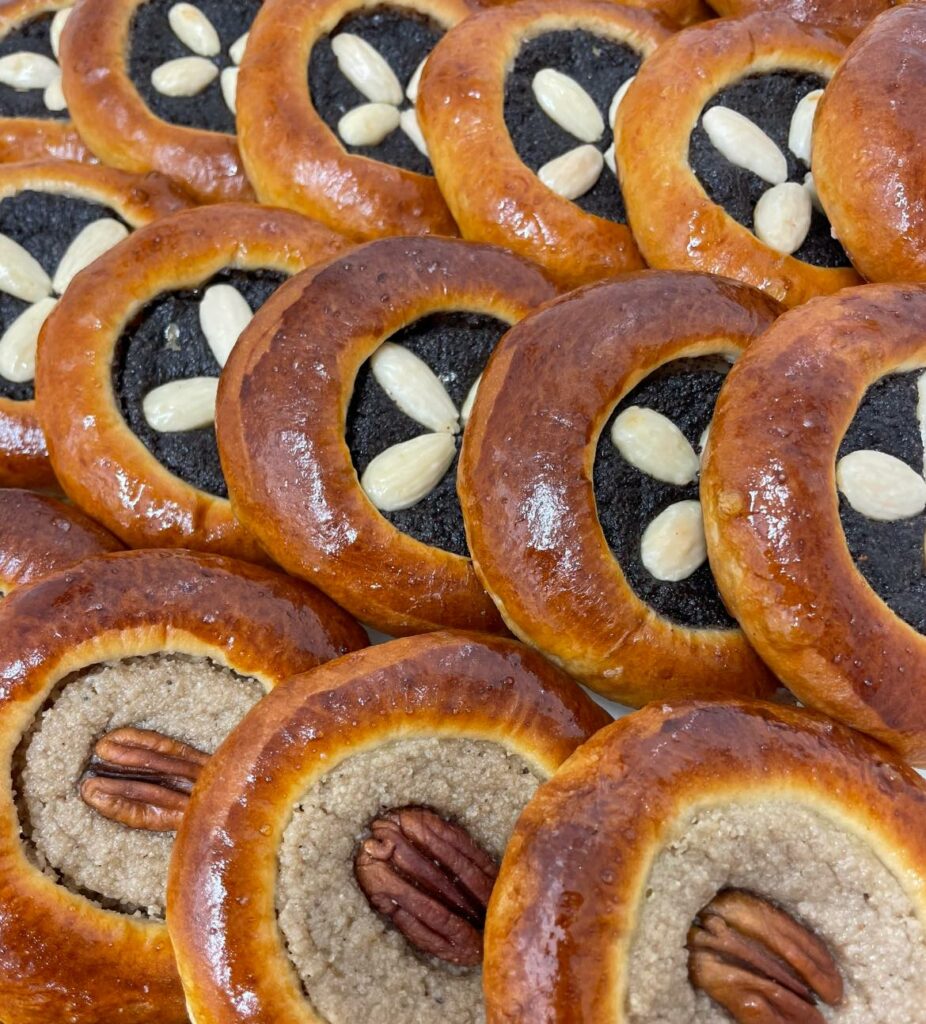
Discover the koláč, the traditional round cake that Czechs eat for breakfast or a snack, and which has been exported as far as the United States. No croissants here (well, they do exist, of course, as far as Scandinavian-inspired bakeries. My favorite Prague pastries are at Arctic Bakehouse!) It’s koláč, filled with apricot jam, poppy (very good!) or tvaroh, (that slightly sour cottage cheese much used here), that dominates. For good koláčky, I recommend two very central addresses: Kolacherie (Czech and Texan cakes) and Krusta.
10 a.m. Tour of Prague Castle and Lobkowicz Palace
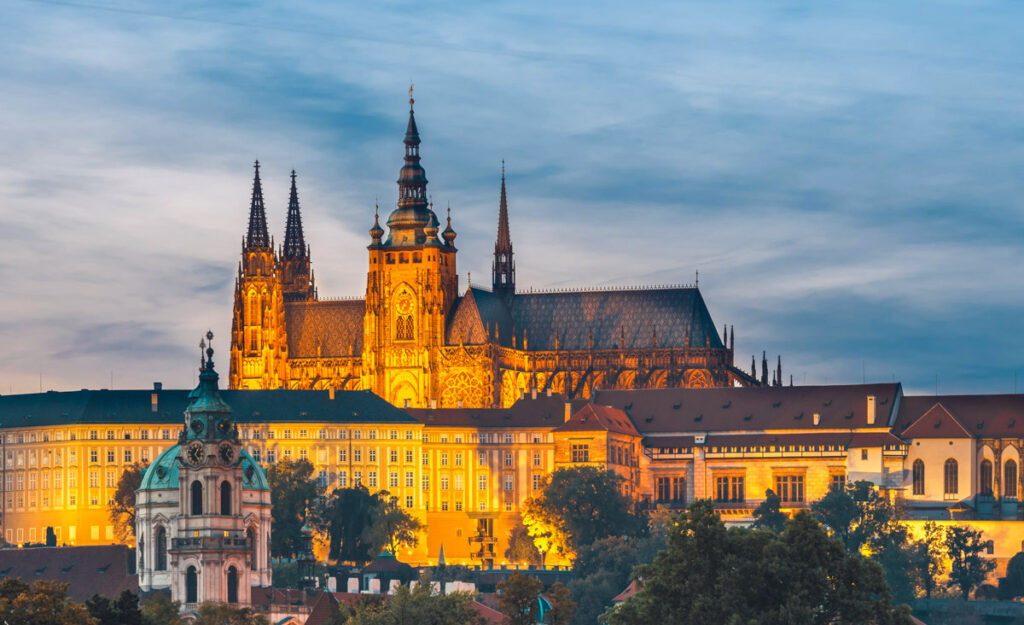
A visit to the Castle, along with the synagogues in the Jewish Quarter and the Clementinum, is a classic paying tour. It’s not compulsory, but it’s well worth it! If you don’t want to visit the Castle, you’ll have to climb it (if possible, by taking one street up and another down, or from Petřín Hill and its Eiffel Tower), wander around the freely accessible complex and admire the view. Great plan! The panorama is best from the Villa Richter, with a few tables on the terrace in fine weather, next to the medieval vines. One of the best views in Prague!
Founded in the 9th century, Prague Castle is, along with the famous Charles Bridge, undoubtedly the city’s most striking symbol. A political, religious and cultural center throughout history, it has been home to the kings of Bohemia and the emperors of the Holy Roman Empire, and today it is the residence of the presidents of the Czech Republic. Its architecture combines Gothic, Baroque and Renaissance elements, and its three major attractions are :
- the majestic Gothic St. Vitus Cathedral, sometimes mistaken for the Castle because of its imposing appearance. It houses the tombs of the Bohemian kings. Superb stained glass windows, including one by the famous Alfons Mucha (pronounced Moura in Czech)
- the former royal palace, residence and coronation palace of the Czech kings, with its monumental Vladislav Hall, where riders could enter with their mounts.
- golden alley and its alchemical past. This is a picturesque little alley lined with pastel-colored houses, which in the Middle Ages served as a district for alchemists and goldsmiths. Kafka later lived at no. 22.
Tickets for the Prague Castle tour : book here.
The Castle tour can be followed by a visit to the Lobkowicz Palace. The palace houses a private museum and an impressive collection of works of art (Brueghel, Canaletto, Velázquez…), collected by the great aristocratic Lobkowicz family. The palace also hosts lovely lunchtime concerts and one of Prague’s prettiest terraces. And for lunch close to the Castle, Kuchyň is a popular address, again with superb views. If you’re looking for more exotic fare, I really like the calm of Malý Buddha, a very old Prague address (Asian cuisine is top quality in Prague). And to complete the picture, if you haven’t found your hotel yet, the Questenberg Hotel, located in a former Baroque palace, will surprise you with its facade and calm!
Combined ticket for Prague Castle and Lobkowicz Palace: book here.
Classical concerts at noon in the Lobkowicz Palace: book here.
2 p.m. Malá Strana district, John Lennon wall, Kampa Island and the famous Charles Bridge
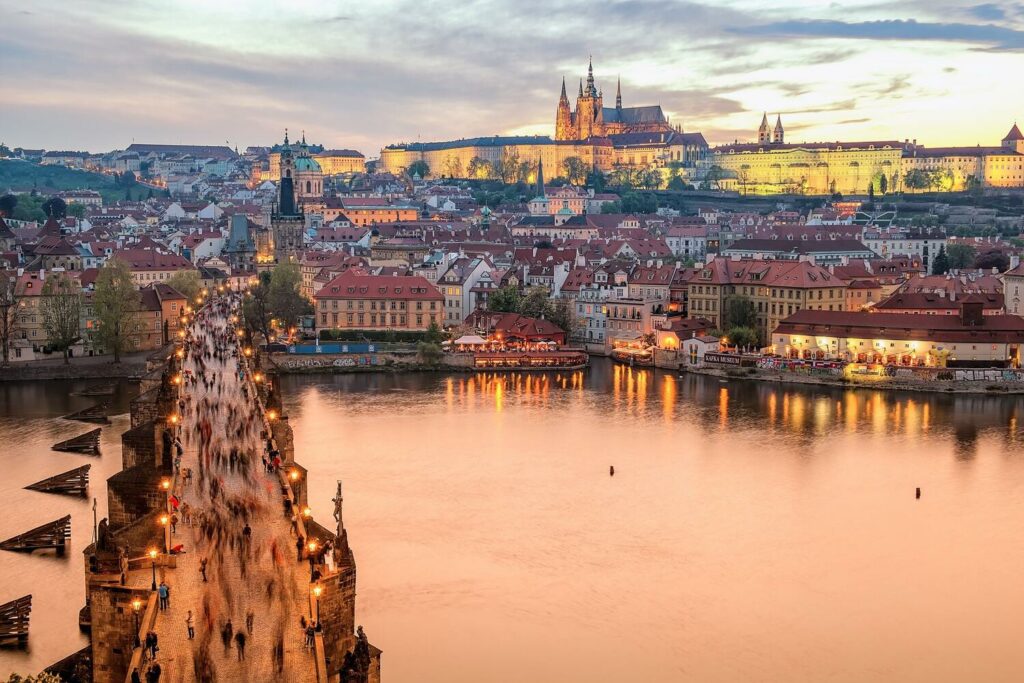
Once off the Castle, it’s time to lose yourself for a good hour in the quiet, picturesque district of Malá Strana and, if possible, visit the Church of St. Nicholas (Baroque in all its splendor!) and its bell tower, which is great to climb! All Malá Strana’s facades are highly ornamented, and there’s a plethora of sign houses (buildings decorated with a distinctive sign that has given its name to the building, which sometimes appears in full letters on the facade: «Aux deux soleils», «Au homard vert», «À la roue d’or»…). There are many, for example, on Nerudova Street.
The John Lennon Wall (owned by the Order of Malta) is located opposite the French Embassy (the pretty baroque Buquoy Palace ). It has been a symbol of peace since John Lennon’s assassination in 1980. After his death, young Praguans, inspired by the Beatles» song of peace, began writing slogans against the communist regime in power. After the Velvet Revolution of 1989, the wall remains a place of artistic and peaceful expression. But make sure you don’t write anything stupid! The neighbor has installed plastic «vegetation» on his wall to keep it from being covered… Once you’ve discovered the wall, take a look at Kampa Island and the babies of David Černý, the must-see Prague artist.
Crossing the Charles Bridge will remain a highlight of your stay (so much so that I advise you to cross it another time after dark for the romantic side). It’s the emblem of Prague. This stone bridge was built in 1357 under Charles IV (as the successor to the wooden Judith Bridge, which fell victim to a flood). At 516 m long, it links the Malá Strana district you’ve just visited with the Old Town. Many of the statues of saints on either side of the bridge are copies (the original ones are protected in casemates that can be visited in Vyšehrad). Saint John of Nepomuk is the most illustrious. The original is associated with one of Prague’s many legends. Do like everyone else and touch the statue of the patron saint of bridges and boatmen for luck! And enjoy one of the city’s finest views, of course!
5 p.m. Prague Astronomical Clock
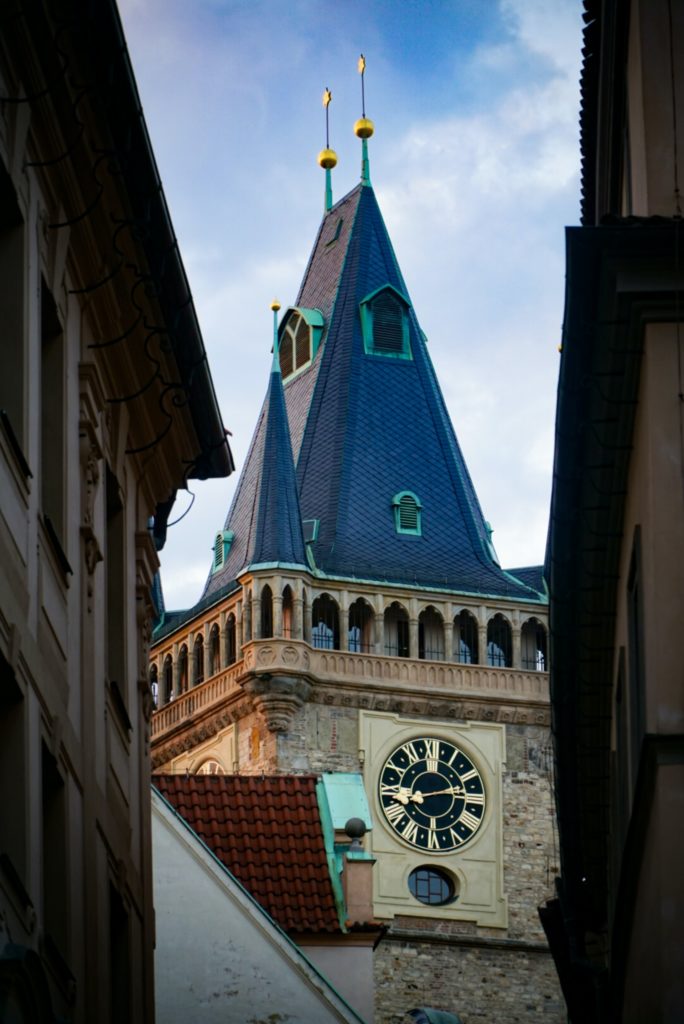
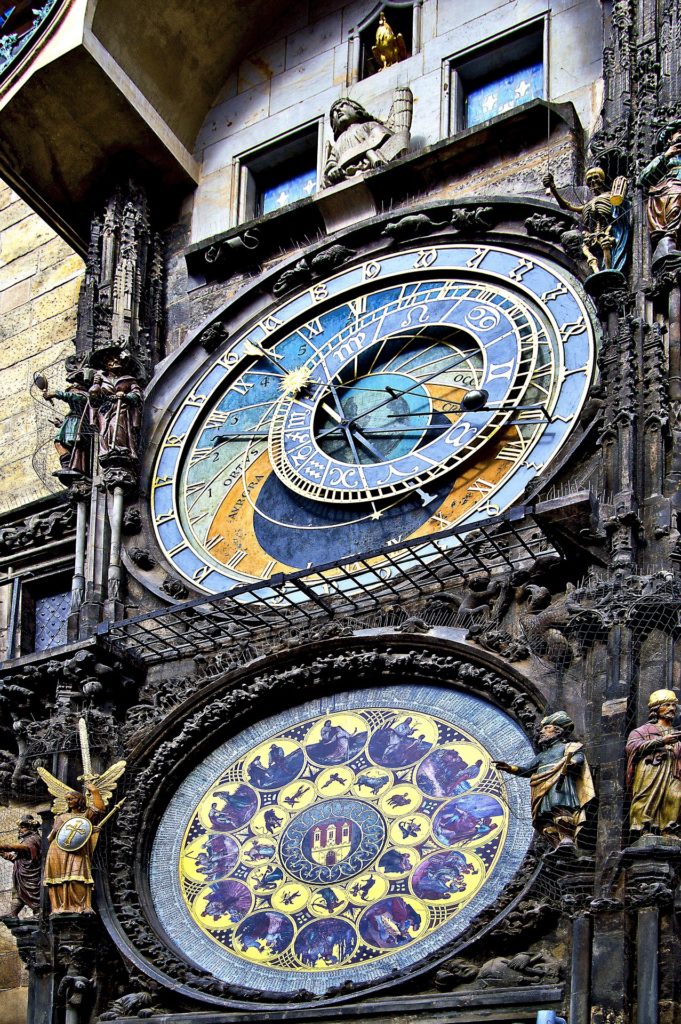
Back to the Old Town to admire the astronomical clock just seen the day before. Designed in 1410, it’s the oldest working astronomical clock in the world. And it’s superb, with its apostles marching past every hour. Don’t miss this little spectacle, because it’s said that you leave Prague unhappy if you haven’t seen it! And here again, a legend! In 1490, the master clockmaker Hanuš modified the clock and, so that he could never reproduce such a marvel elsewhere, had his eyes gouged out.
Discover Prague’s astronomical clock tower with tickets here.
6.30 p.m. Dancing House
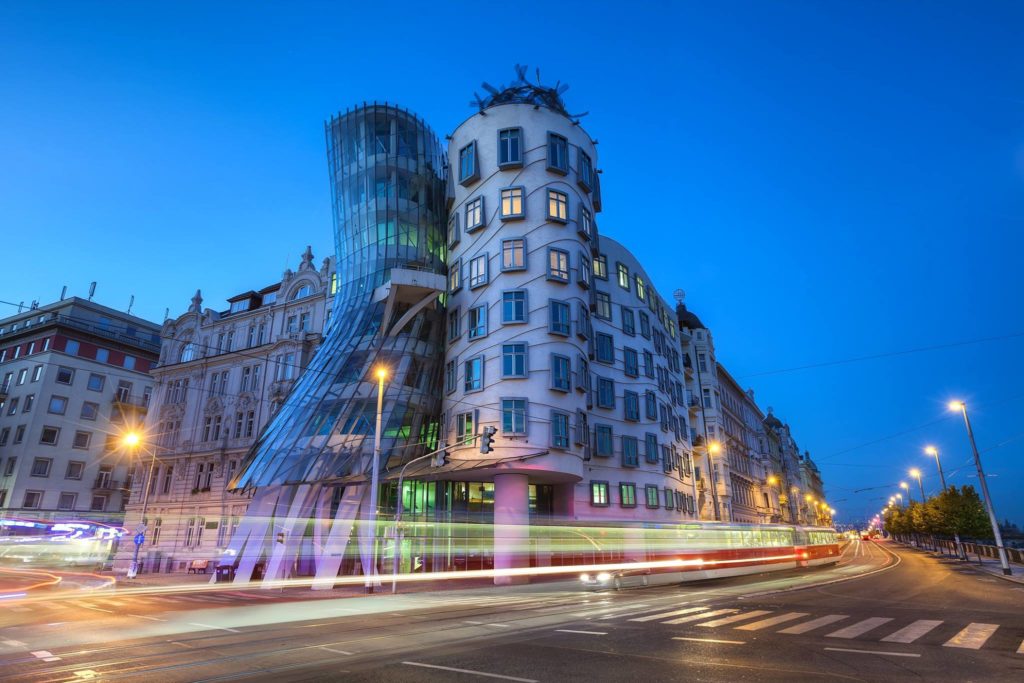
Nicknamed «Ginger and Fred» (after the famous dancers Fred Astaire and Ginger Rogers), this is Prague’s best-known and most photographed modern architecture building. The concrete tower with the «little hat» dominating it is Fred, the glass one flared at the bottom like a dress is Ginger.) The deconstructivist Dancing House is located in the New Town, on the banks of the Vltava (I recommend a stroll along the quays below, especially on sunny days, or on Saturday mornings, when the market is open! The whole area between the National Theatre and Vyšehrad Hill is a great place to visit). The Dancing House, completed in 1996, was designed by architects Vlado Milunić and Frank Gehry, and was built by the first Czech president, Václav Havel. During the Communist era, he lived in the adjoining building and the street behind it (a plaque on a small Vietnamese restaurant on Gorazdova Street informs us that Havel had lunch there with his buddies the Rolling Stones; take a stroll down Gorazdova Street, with its superb Art Nouveau facades, you won’t regret it!) Built in place of a building destroyed during the Second World War, the Dancing House is sometimes criticized for its radical style (as is the Brutalist annex of the nearby National Theatre), but it represents the modernity that Prague has always sought to embody in its diverse and colourful architecture. Within the Dancing House you’ll find a café and a panoramic restaurant offering superb views of the city.
8 p.m. Mozart or medieval dinner
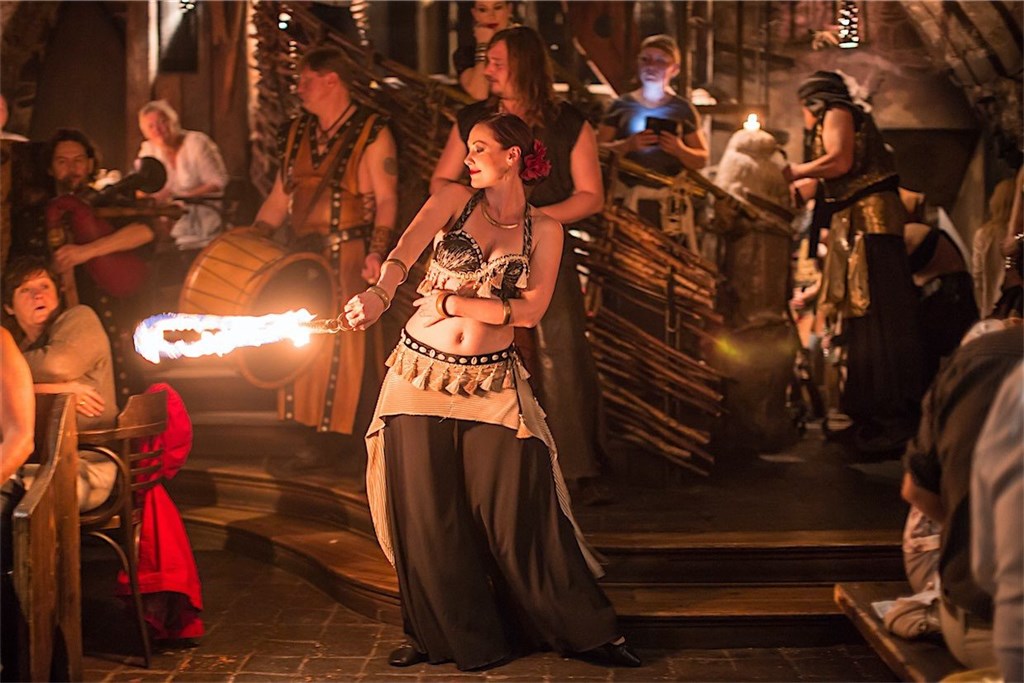
There’s something for everyone in Prague, and to round off this wonderful day in a memorable way, there are two options (it’s best to book in advance). Either the splendor of the opera dinner offered in the Boccaccio Room, restored in 1993 and hidden in the basements of the fabulous Grand Hotel Bohemia. You’ll dine under a sparkling chandelier (4,000 crystal pieces). The fixtures, both old and new, combine two local strengths: expertise in glass and crystal work and a taste for design. They are truly emblematic of Prague furniture. Music lovers will be delighted to hear Mozart arias sung in period costumes and in a refined atmosphere (concerts at the nearby Spanish Synagogue or Chapel of Mirrors are also very popular, you should know!)
Then it’s time for a change of (more saucy) register with the equally popular medieval dinner! Czechs are nostalgic for two periods: the First Czechoslovak Republic (the prosperous period between 1918 and 1938, after the Austro-Hungarian Empire and before the arrival of the Nazis and then the Communists) and the Middle Ages, when silver mines in the east made Prague and the country rich. Castles everywhere, a taste for historical re-enactments and therefore medieval dinner shows often housed in the Gothic vaulted cellars of the Old Town. U Pavouka is located in the heart of Prague: medieval decor, hearty cuisine typical of the period (roasted meats, root vegetables, homemade bread, all accompanied of course by beer or wine). Not to mention the shows! Folk dancing, juggling, fire-eating, knights in armor… A very convivial and festive experience that always pleases!
To book a Mozart dinner, click here.
To book a medieval dinner (U Pavouka is probably the most popular, with unlimited drinks), click here.
Day 3: Jewish Quarter, Vítkov and Vyšehrad hills, Vinohrady bourgeois-bohemian district…
- 9 a.m. Prague’s Jewish Quarter
- 1 p.m. Lunch break
- 2.30 p.m. Powder Tower, Black Madonna House, St. James Church and coffee at the Municipal House
- 4 p.m. Vítkov or Vyšehradhill
- 7 p.m. Buy a souvenir
- 8:30 p.m. Dinner in the bourgeois-bohemian district of Vinohrady
9 a.m. Prague’s Jewish Quarter
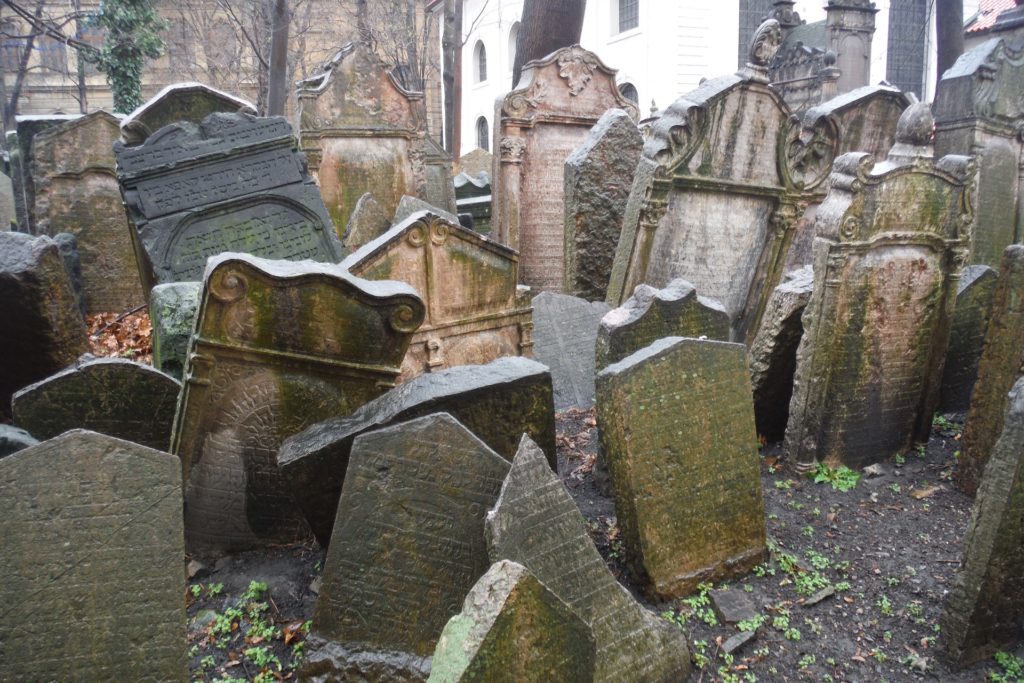
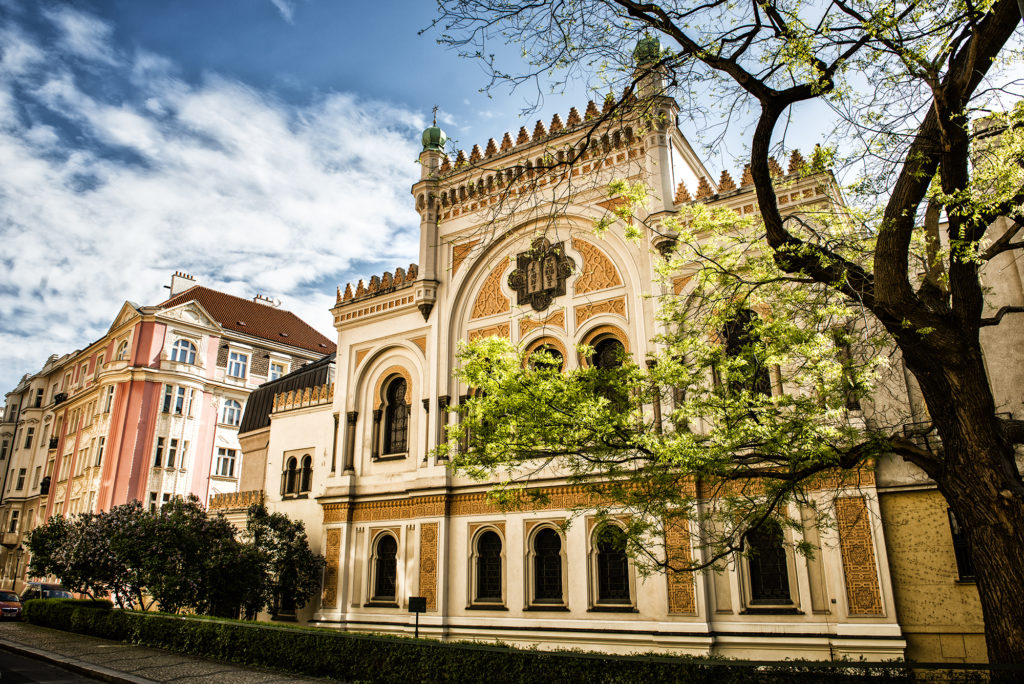
Get up early to make the most of this last day of sightseeing and visit the superb Jewish quarter of Josefov as soon as the synagogues open. Prague’s Jewish Quarter is one of the oldest in Central Europe (don’t say Eastern Europe, you’ll offend the locals!) it’s an unforgettable place, with a unique old Jewish cemetery with 12,000 intertwined headstones, and synagogues all different from one another, each with its own small exhibition: the Maisel synagogue shows the daily life and traditions of Bohemian Jews, while the Pinkas synagogue pays tribute to the 80,000 Czech Jewish victims of the Holocaust… And don’t forget to take an hour’s stroll through the Jewish quarter, where the Art Nouveau facades are so beautiful! They’re some of the most beautiful in the city, and you can cover all the streets in the Jewish Quarter in an hour, because it’s so small (enclosed in a curve of the Vltava River).
To book a tour of the Jewish Quarter, look here or here.
1 p.m. Lunch break
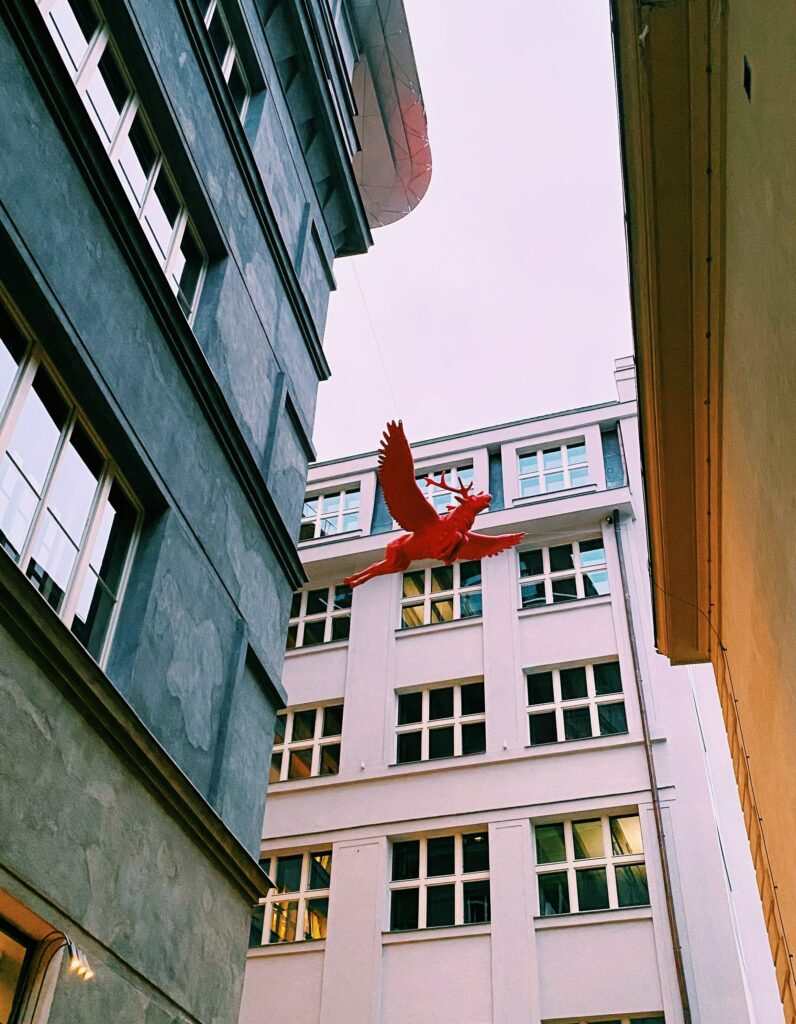
I love Červený jelen (this restaurant already suggested for lunch on the first day). An establishment with very Prague volumes opened in 2019 opposite the superb Hotel Central with its Art Nouveau architecture. The cubist-modernist space of the former AngloBank, created by Josef Gočár between the two world wars, has been transformed into a unique restaurant by Czech architect Stanislav Fiala. The first owner of the palace housing the restaurant was Count Špork, the founder of Czech hunting and the Order of St. Michael. His penchant for hunting is indicated not only by the name of the restaurant (Le Cerf rouge), but also by the statues of flying deer (Michal Gabriel) in the newly built alleyway of Saint-Hubert, the patron saint of hunters and gamekeepers. Very Prague volumes on 4 levels! Former vault room in the basement, 9 meters of stacked beer tanks… Find out more about this restaurant in this blog post! Not far away, two other options and nice restaurants with Farina for Italian cuisine (often of high quality in Prague) or Restaurace Hybernská for Czech cuisine.
2.30 p.m. Powder Tower, Black Madonna House, St. James Church and coffee at the Municipal House
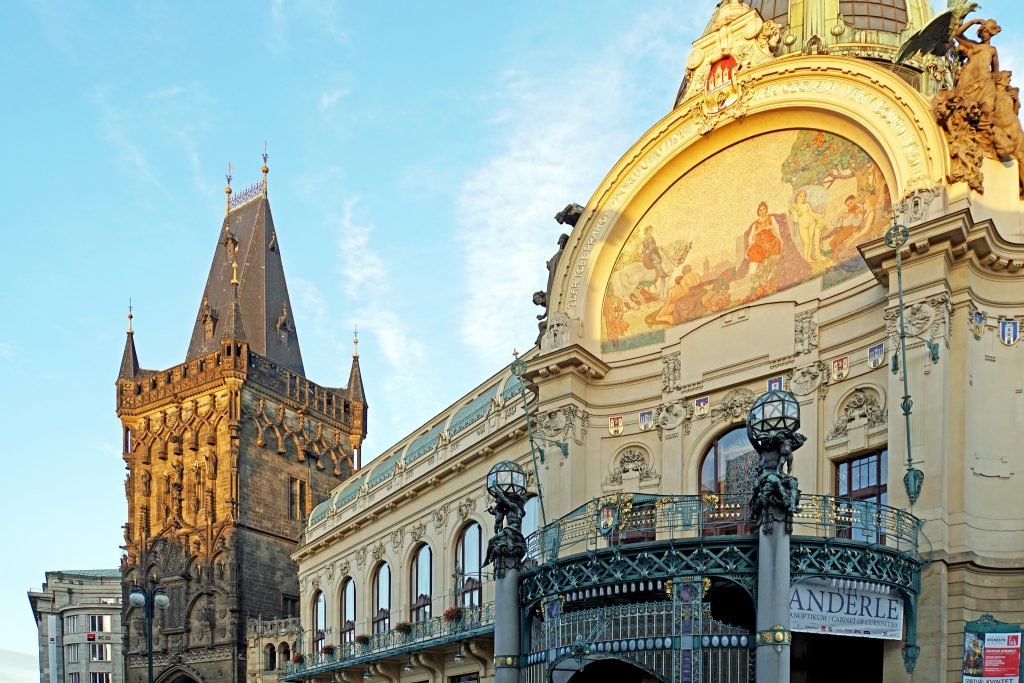
The early afternoon can be devoted to pretty monumennts, very different and not far apart.
- The Powder Tower (tickets here). Built in 1475, this Gothic tower was the gateway to the Old Town. It introduces the Royal Way, the path followed by the kings of Bohemia on their coronation to the Castle. Poudrière (gunpowder magazine): in the 17th century, gunpowder was stored here. Partially destroyed during the Prussian War in 1757, it was restored in neo-Gothic style by Josef Mocker in the 19th century. Adorned with sculptures of kings and saints, it is 65 m high and you can climb the 186 steps of its spiral staircase for a superb view (personally, I’ll always prefer the view from the St. Nicholas tower in Malá Strana).
- The Church of St. James the Greater. This baroque Gothic church conceals a most unusual object: the thief’s famous severed hand!
- Art Palace. After years of closure, this former bank now houses an exhibition space. It’s a unique place, quite representative of the incredibly well-furnished banks and insurance companies that the Czech capital had built in the 19th century, and a good illustration of the city’s wealth at the time.
- The Municipal House houses a restaurant (very good-value menu at lunchtime on weekdays) and a café on the first floor that’s a must-see! Not to mention the freely accessible brewery room in the basement (Prague is full of oversized cellars).
4 p.m.: Vítkov Hill or Vyšehrad Hill

You probably won’t have time to do both. The choice is yours!
- Vítkov Hill. Highlights: You’ll find a lovely view, one of the world’s largest equestrian statues (unforgettable!), the 14-18 legionnaires« memorial, reminiscent of communism before its time, and a fantastic army museum (one of my 3 favorite museums)! And it’s all free (memorial and museum closed on Mondays).
- Vyšehrad Hill. Highlights: You’ll find a lovely view, a beautiful basilica containing a St. Valentine’s relic, casemates and a cemetery that serves as a Czech pantheon.
7 p.m. Buy a souvenir
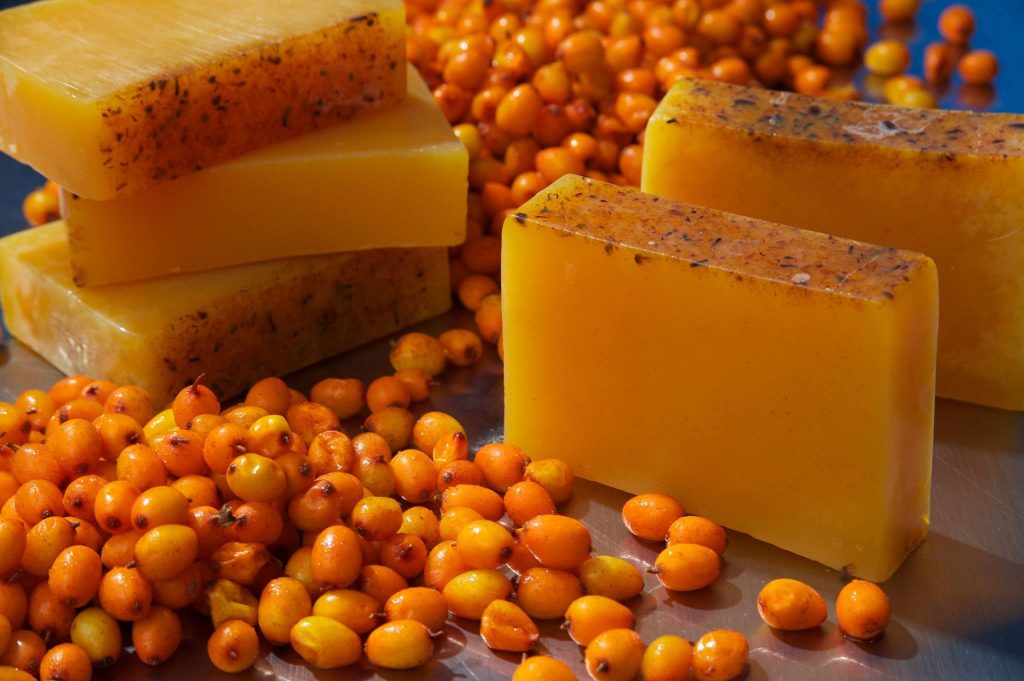
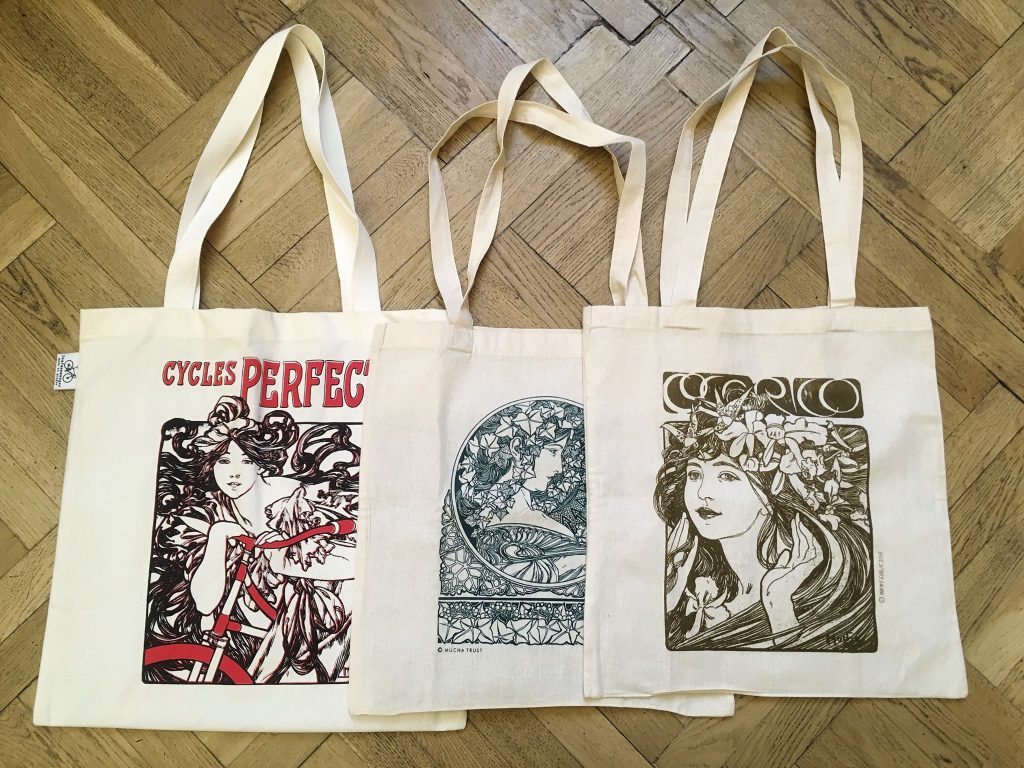
As the end of your stay approaches, there’s still time to buy a nice souvenir. If you’re in a hurry, you can buy a natural cosmetic from Manufaktura, a chain present everywhere, right up to the airport. The more affluent can take a look at the crystal offered by a glassmaker like Moser (one of my favorite glassmakers).
8:30 p.m. Dinner in the bourgeois-bohemian district of Vinohrady
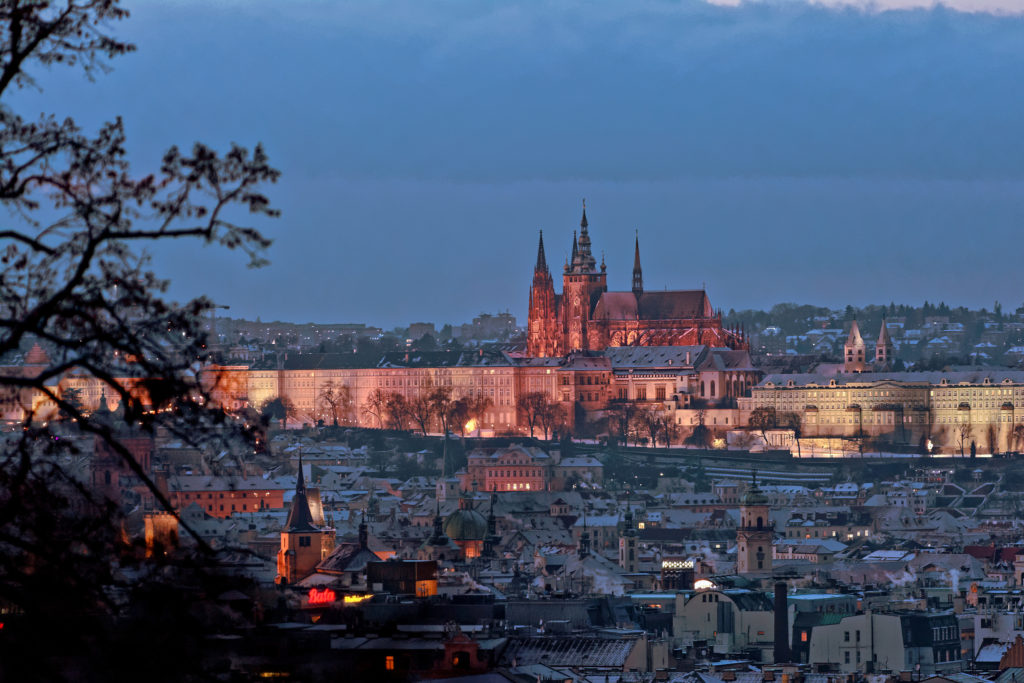
For the perfect end to your stay, book a dinner in Vinohrady and eat Vietnamese at Madame Lyn or Italian at Aromi (Vietnamese and Italian cuisines are very present in Prague, with top-quality restaurants). And for a final farewell to the city, the nearby Riegrovy sady park offers a magical view of the illuminated Castle!